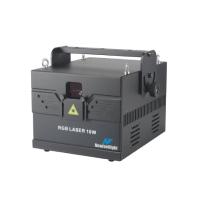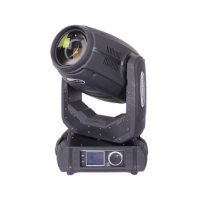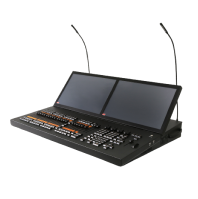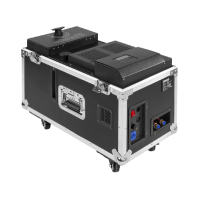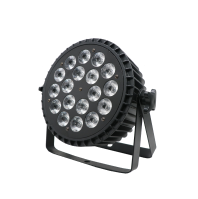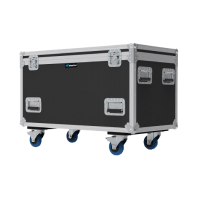Table of Contents
- 1. Laser Fundamentals: Explain the Principle of Laser
- 2. How Is Laser Light Produced in Practice?
- 3. Why Laser Light Is So Energetic and Focused
- 4. Laser Control Systems: From ILDA to FB4 to DMX
- 5. Use Cases: Where the Laser Working Principle Shines
- 6. Why Choose Newfeel Light for Professional Laser Systems
- Conclusion: The Science Behind the Spectacle
In today’s professional lighting and stage production industries, lasers are far more than just eye-catching visual effects—they’re essential tools of precision and performance. Whether you're configuring a high-end laser show system, managing synchronized stage displays, or investing in durable professional laser lights for outdoor events, understanding the laser working principle is critical.
At Newfeel Light, we design every projector with advanced optical technology that builds directly on the scientific fundamentals of laser generation. But how does a laser work, and what gives it such extraordinary energy and focus? In this guide, we explore the laser fundamentals, walking through the complete process—from atomic excitation to controlled emission—so you can make smarter equipment choices for your business.
1. Laser Fundamentals: Explain the Principle of Laser
To understand the power and precision behind a modern stage laser projector, it helps to start with a basic definition: LASER stands for Light Amplification by Stimulated Emission of Radiation. That acronym reflects the entire principle of laser technology: using the quantum mechanical behavior of atoms to generate a beam of light that is uniquely focused, coherent, and high in energy.
In ordinary light sources, photons are emitted in random directions and phases. But how is laser light produced? The answer lies in stimulated emission—a process where an incoming photon triggers an excited atom to emit a second photon that is perfectly synchronized in phase, direction, and wavelength. This is what makes laser light so incredibly pure and stable.
The key steps in the laser working principle include:
Population Inversion: Energizing a medium (gas, crystal, or diode) so that more particles are in an excited state than at ground level.
Stimulated Emission: Using an existing photon to stimulate the emission of additional, identical photons.
Optical Resonance: Reflecting these photons between mirrors to amplify their numbers and create a directed beam.
When you explain the principle of laser in practical terms, you’re describing how atomic-level physics becomes a usable, high-power light source.
2. How Is Laser Light Produced in Practice?
Now that we’ve covered the theory, let’s discuss how laser light is produced in actual devices. A laser show system—like those used in concerts, stadiums, or festivals—contains an active laser medium, a pumping mechanism, and an optical resonator.
The active medium is energized through electrical current, light, or another method. Once population inversion is achieved, stimulated emission starts amplifying the light. Two mirrors bounce these photons back and forth, creating a chain reaction that ultimately produces a powerful beam of laser light. One of these mirrors is semi-transparent, allowing the amplified light to escape as a laser beam.
In Newfeel Light’s professional laser projectors, this process is refined through high-quality optics, thermal management systems, and safety features to ensure consistent, powerful output across long distances and in demanding environments.
3. Why Laser Light Is So Energetic and Focused
One of the reasons laser technology stands apart in professional applications is its energy density and directionality. The secret to this lies in the consistent behavior of photons created through stimulated emission.
Because all photons in a laser beam have the same wavelength, direction, and phase, the resulting light:
Can be focused into an extremely narrow spot (used for cutting, engraving, or high-resolution projection)
Maintains high coherence over long distances, ideal for outdoor mapping or beam effects
Delivers extremely high brightness, outperforming traditional light sources in intensity and clarity
This is what makes laser systems so vital in laser show setups, concert lighting, brand activations, and immersive projection experiences.
4. Laser Control Systems: From ILDA to FB4 to DMX
Of course, producing a laser beam is only the first step. Professionals need advanced tools to control, program, and synchronize their lighting. That’s why Newfeel Light offers products compatible with:
ILDA laser control: The international analog standard for precise graphic output and animation.
DMX laser systems: Fully compatible with DMX512 signal protocols for complete stage show integration.
FB4 laser interfaces: Ethernet-based control that allows real-time updates and complex programming via software like Pangolin.
These systems give users full command over brightness, beam shape, color mixing (RGB laser), and timing—making every laser light show highly customizable and scalable for different venue sizes.
5. Use Cases: Where the Laser Working Principle Shines
Once you understand how lasers work, you begin to see their potential in a wide range of professional scenarios. At Newfeel Light, we design each product line to serve the following industries:
Concerts & Festivals: Massive stages use synchronized stage lasers to deliver immersive visual experiences.
Corporate Events: Logos, messages, and animated patterns can be projected with pinpoint accuracy using laser show systems.
Outdoor Installations: Our outdoor laser lights are built with IP-rated waterproof casings and powerful beams for weather-resistant projection.
Theme Parks & Attractions: Whether used in rides or water shows, the high brightness and directivity of lasers create unmatched visual drama.
Architectural Mapping: Lasers can cover building facades with patterns or 3D-like animations, thanks to the precise control enabled by FB4 or ILDA standards.
Whether you need a plug-and-play model for mobile setups or a professional laser light system for permanent installations, understanding the laser working principle ensures you get the performance and reliability your project demands.
6. Why Choose Newfeel Light for Professional Laser Systems
At Newfeel Light, we apply the principle of laser with engineering precision to develop durable, high-performing systems trusted by professionals worldwide. Our projectors are known for:
Advanced scanning systems (up to 30KPPS)
Support for laser RGB with accurate white balance
Intelligent cooling systems for continuous operation
ILDA/DMX/FB4 multi-protocol compatibility
Modular designs that simplify upgrades and maintenance
Whether you’re running a live event or building a fixed installation, our gear is designed to deliver maximum impact with minimal setup complexity.
Conclusion: The Science Behind the Spectacle
So, how does a laser work? It starts at the quantum level—with a precise dance of particles and photons—and ends in the stunning effects you see on stage or in the sky. By understanding the laser working principle, lighting professionals gain the insight needed to select the right equipment, troubleshoot effectively, and create unforgettable visual experiences.
As technology evolves, laser systems continue to push boundaries in clarity, color, and control. At Newfeel Light, we’re proud to be part of that evolution—transforming quantum theory into visual art.






